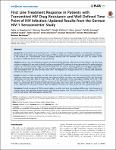First Line Treatment Response in Patients with Transmitted HIV Drug Resistance and Well Defined Time Point of HIV Infection: Updated Results from the German HIV-1 Seroconverter Study
Knyphausen, Fabia zu
Scheufele, Ramona
Kücherer, Claudia
Jansen, Klaus
Somogyi, Sybille
Dupke, Stephan
Jessen, Heiko
Schürmann, Dirk
Hamouda, Osamah
Meixenberger, Karolin
Bartmeyer, Barbara
Background: Transmission of drug-resistant HIV-1 (TDR) can impair the virologic response to antiretroviral combination therapy. Aim of the study was to assess the impact of TDR on treatment success of resistance test-guided first-line therapy in the German HIV-1 Seroconverter Cohort for patients infected with HIV between 1996 and 2010. An update of the prevalence of TDR and trend over time was performed. Methods: Data of 1,667 HIV-infected individuals who seroconverted between 1996 and 2010 were analysed. The WHO drug resistance mutations list was used to identify resistance-associated HIV mutations in drug-naïve patients for epidemiological analysis. For treatment success analysis the Stanford algorithm was used to classify a subset of 323 drug-naïve genotyped patients who received a first-line cART into three resistance groups: patients without TDR, patients with TDR and fully active cART and patients with TDR and non-fully active cART. The frequency of virologic failure 5 to 12 months after treatment initiation was determined. Results: Prevalence of TDR was stable at a high mean level of 11.9% (198/1,667) in the HIV-1 Seroconverter Cohort without significant trend over time. Nucleotide reverse transcriptase inhibitor resistance was predominant (6.0%) and decreased significantly over time (OR = 0.92, CI = 0.87–0.98, p = 0.01). Non-nucleoside reverse transcriptase inhibitor (2.4%; OR = 1.00, CI = 0.92–1.09, p = 0.96) and protease inhibitor resistance (2.0%; OR = 0.94, CI = 0.861.03, p = 0.17) remained stable. Virologic failure was observed in 6.5% of patients with TDR receiving fully active cART, 5,6% of patients with TDR receiving non-fully active cART and 3.2% of patients without TDR. The difference between the three groups was not significant (p = 0.41). Conclusion: Overall prevalence of TDR remained stable at a rather high level. No significant differences in the frequency of virologic failure were identified during first-line cART between patients with TDR and fully-active cART, patients with TDR and non-fully active cART and patients without TDR.
Dateien zu dieser Publikation
Keine Lizenzangabe
Verwandte Publikationen
Anzeige der Publikationen mit ähnlichem Titel, Autor, Urheber und Thema.
-
2010-10-14ZeitschriftenartikelMethicillin-resistant Staphylococcus aureus (MRSA): burden of disease and control challenges in Europe Köck, Robin; Becker, Karsten; Cookson, B.; Gemert-Pijnen, J. E. van; Harbarth, S.; Kluytmans, J.; Mielke, Martin; Peters, G.; Skov, R. L.; Struelens, M. J.; Tacconelli, E.; Torné, A. Navarro; Witte, Wolfgang; Friedrich, Alexander W.Methicillin-resistant Staphylococcus aureus (MRSA) is a major cause of healthcare- and community-associated infections worldwide. Within the healthcare setting alone, MRSA infections are estimated to affect more than 150,000 ...
-
2010-06-01ZeitschriftenartikelXenotropic Murine Leukemia Virus–related Gammaretrovirus in Respiratory Tract Fischer, Nicole; Schulz, Claudia; Stieler, Kristin; Hohn, Oliver; Lange, Christoph; Drosten, Christian; Aepfelbacher, MartinXenotropic murine leukemia virus–related gammaretrovirus (XMRV) has been recently associated with prostate cancer and chronic fatigue syndrome. To identify nucleic acid sequences, we examined respiratory secretions by using ...
-
2014-07-24ZeitschriftenartikelSystematic literature analysis and review of targeted preventive measures to limit healthcare-associated infections by meticillin-resistant Staphylococcus aureus Köck, Robin; Becker, Karsten; Cookson, B.; Gemert-Pijnen, J. E. van; Harbarth, S.; Kluytmans, J.; Mielke, Martin; Peters, Georg; Skov, R. L.; Struelens, Marc J.; Tacconelli, E.; Witte, Wolfgang; Friedrich, Alexander W.Meticillin-resistant Staphylococcus aureus (MRSA) is a major cause of healthcare-associated infections in Europe. Many examples have demonstrated that the spread of MRSA within healthcare settings can be reduced by targeted ...

